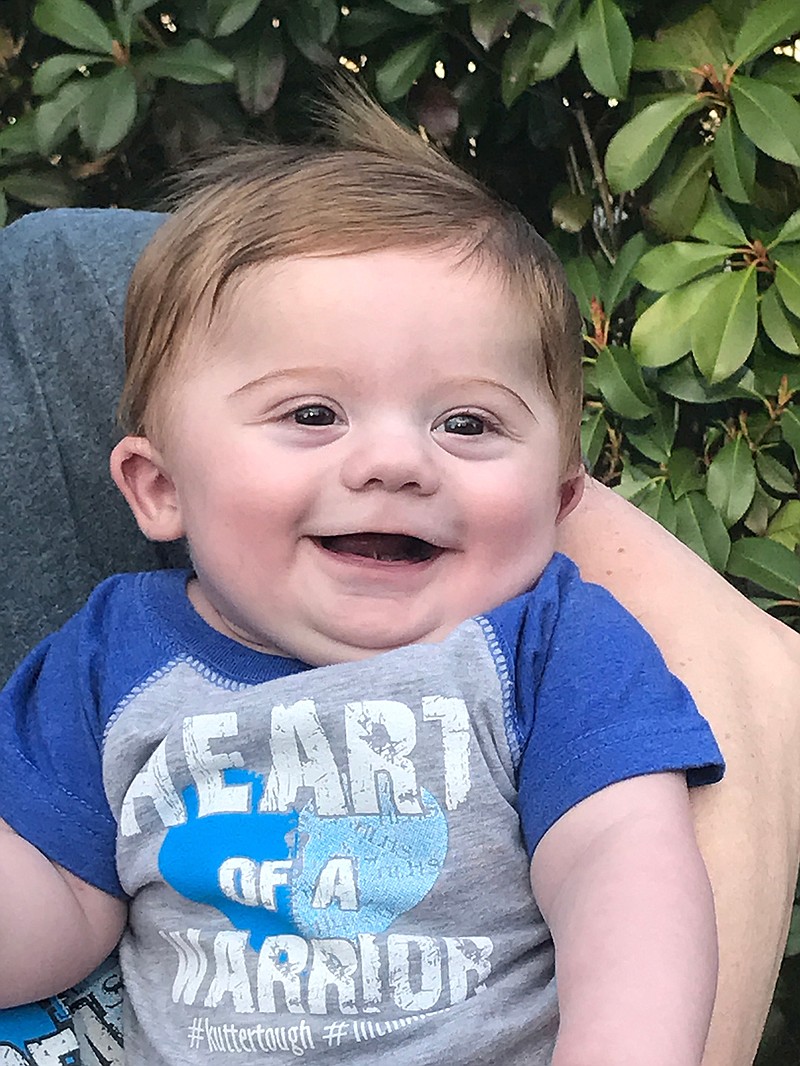Kutter Lane "Lil Tin Man" Harman has already crossed mountains in his first seven months of life.
Kutter was diagnosed in utero with hypoplastic left heart syndrome, which means the left side of his heart didn't develop like it should.
Since he was born Aug. 2, 2017, at a Dallas hospital, he has had two major heart surgeries, one of which was done within 24 hours of his birth. He'll have another major surgery sometime between 18 months and 3 years of age.
The surgeries are part of the Norwood Procedure, a three-step process that aims to create normal blood flow in and out of the heart. They are necessary, life-saving procedures for babies with hypoplastic left heart syndrome. The other alternatives are a heart transplant or death.
His parents, Wendy and Justin Harman, found out about Kutter's congenital heart defect when Wendy was 20 weeks pregnant and received a Level 2 ultrasound to screen for spina bifida.
"It was a miracle we found out ahead of time. If Wendy hadn't been 35 years old, they never would have sent her for a Level 2 ultrasound," Justin said.
The results of the ultrasound were overwhelming for the Harmans. Everything was normal besides Kutter's heart. Many tears were shed over the news.
"It was sheer shock. That's the best way I know to describe it," Wendy said. "I sat there while the doctor was talking to us in a daze for the first several minutes. After a few minutes, I realized he was repeating what he was saying, 'Your baby is not going to survive if you do not have these operations done, and there are only so many surgeons in the country that can do these surgeries, and he has to have them. You have a long road ahead of you, and it's going to be rocky.' He kept saying it over and over again, and I realized he was saying it again because I was not reacting at all.
"Justin put his hand on my shoulder, and I think that's when it kind of brought me back into the room," Wendy said. "They cleared the room and let us have it for a few minutes, and we did cry. Then Justin said, 'We're Harmans. We'll get through this. It's what we do.'"
The ride home from that ultrasound in Little Rock was spent calling loved ones and telling them about the challenges ahead.
"We'd make one phone call at a time, then we'd hang up the phone and cry, call someone else, hang up the phone and cry," Wendy said. "We did that for four or five days, maybe longer than that."
A family friend put them in contact with someone at Medical City Children's Hospital in Dallas, where there was a surgeon who performed the surgeries Kutter would need.
"We went to Dallas and checked out Medical City. Before we walked in the door, we said we weren't going to make any decisions on where we go today. We had plans to go visit a hospital in Houston. Instead, we walked out the door and said we didn't want to go anywhere else," Wendy said.
During that visit, the Harmans toured the congenital heart surgery unit and were quite impressed. They got a glimpse of the struggles their child would face, but they also had a chance to see survivors.
"Going on that tour that day was the most relieving, horrific thing we've ever experienced in both our lives, if that can possibly make sense," Justin said.
"They take you through and basically show you what your child is going to look like, and I'm still pregnant at this point," Wendy said. "We saw this baby confined to a hospital bed, and they've got 20 something pumps attached to them and lines coming off from everywhere. There are things beeping and blinking and buzzing."
"I don't know the name of the one kid we saw hooked up to all that stuff, but I've prayed for him every night since that day," Justin said.
Once a course of treatment was chosen, preparations were made for Wendy to deliver by C-section in Dallas on Aug. 15. Instead, she went into labor Aug. 2 in Texarkana and had to be flown to Dallas to deliver by emergency C-section.
"There's a flap that closes off within the first 24 hours after a baby is born, and it basically tells the heart the placenta is not there anymore and it needs to start using the lungs. Because Kutter didn't have the left side of his heart, he couldn't pump to and from the lungs. That flap had to remain open for the surgeons to do their job. That's part of the reason we couldn't deliver here," Wendy said.
Kutter was born at 10:52 p.m. Aug. 2, and by 5 the next morning, doctors were taking him back for an eight-hour surgery. It was a long wait for the new parents.
"They'd come in every hour pretty much like clockwork and let us know what was going on," Justin said.
At 10:30 p.m., doctors came in and told the Harmans that Kutter was being placed on extracorporeal membrane oxygenation.
"We later found out what that actually meant. He was on life support for four days. We didn't realize how serious it was. ECMO is a heart/lung machine that serves the work of the heart and the lungs so it was breathing for him and it was beating for him," Wendy said.
Kutter remained in the hospital for 10 weeks. Wendy moved into his hospital room to take care of him. Justin went back to work and responsibilities at home. It was a tough time for the family.
Kutter's recovery was complicated by severe milk and soy allergies, but he was finally discharged Oct. 9, and the family had to figure out their new normal.
"It was a shock all over again," Justin said. "Wendy was out there for too long. I was still coming home and working and doing whatever needed to be done. We had to learn to live with each other again and with him. We'd both been through the biggest trauma we'd ever dealt with in our lives. We handled it very well as far as helping each other, but when we got home, we had to learn to live again. I guess that's the best way to put it."
It took a while for the Harmans to settle into life. About the time they did, it was time for Kutter's second surgery, the bi-directional Glenn operation. This time, things went smoothly and Kutter was out of the hospital after 11 days.
"They said to let him be a normal baby," Justin said.
And normal he is. Kutter's early struggles haven't stolen his smile or the calm disposition his parents are thankful for.
"It takes your breath away. He's happy all the time. He never even gets fussy," Justin said.
He's only slightly behind the expected developmental milestones because of his time spent in the hospital.
"Out of seven months, he's been in the hospital for four months total, so we're trying to catch up. We've got a developmental therapist and speech therapist coming, and we're trying to get him caught up with where he's supposed to be," Wendy said.
"Whatever we expected normal to be, we didn't have any idea. Now, this is our normal. We have a baby that loves playing with his toes. He loves making boat sounds or any explosive sound with his mouth, and he loves the sound of explosions. He pinches just like normal baby boys do, he stinks and he flirts," she said with a laugh.
The Harmans wanted to share their story to emphasize the need for a Level 2 ultrasound when expecting a baby. Hypoplastic left heart syndrome is often not diagnosed until babies are born, making it more difficult to get them the treatment they need while there's still time.
"This condition is 100 percent fatal if it's not treated. The baby will die. There's no uncertainty about that. I think that's the biggest message right there. Every woman who's expecting needs to request a Level 2 ultrasound. It's not 3-D or 4-D. It's just a Level 2 that allows them to be able to see blood flow through the heart, and it will find it. That's the only way to detect it beforehand," Wendy said.
Keep up with Kutter's progress on Facebook at Kutter Lane "Lil Tin Man," where he's a pretty popular dude with nearly 6,000 followers from all over the world.


